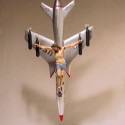
History, according to Gramscy, is the story of men who join other men, many men and all the men of the world to fight, work, and do the best for themselves and society. León Ferrari (1920-2013) was not necessarily a Gramscian, but a serious political activist, as some artists of his generation. In 1976, he exiled in São Paulo and developed a critical approach devoid of contemporary cliché of militancy and helped boost the political and artistic conscience of the country.
The almost 100 works exhibited around the theme León Ferrari: Between Dictatorships, now showing at MASP, are evidence of his struggle against the anti-democratic forces that raised in Latin America in the 60s, 70s and 80s. His work has been a case study for many theorists, but not the object of study. What most intrigues in this show/tribute is the almost mathematical model of his heliographs that can be read as a way of organizing the bureaucracy that supports repression. León Ferrari made dozens of versions of this work, especially when he was in exile in Brazil, showing the long journey a person is subject to when in search of missing information, without ever getting nowhere. He had a sense of humour and the guts to create this maze, where the search triggers multiple reinterpretations of life dissolution. Between dictatorships is a family album with stories that are shared by two countries. His way of thinking was complex, with power and range for experts … in dictatorships.
The two MASP rooms are equally disturbing and welcome the works as “refugees” of terror. His sharpness softens the facts, as evidenced by the nearly 100 works that criticize and question the military regimes and the wave of authoritarianism, which affected Latin America during the 70s. Curated by the artistic director Adriano Pedrosa, MASP curator deputy Julieta González and curator Tomás Toledo, Among Dictatorships shows the role of León Ferrari as promoter of conceptual vanguard and politics in Argentina, who starts working with metallic sculpture in 1962 and to question, at the same time, the linguistic relationship between image and writing in his Quadros Escritos. These drawing poems and news precede the British group Art & Language in 1969. From 1966 to 1970 the Vietnam War becomes the central theme of his work.
The MASP has a representative collection donated by Leon Ferrari. If we take a close look at this collection, we see that the heliographs, the photographs, two paintings, two sculptures and an object stand out. The set is not large, but it is enough for one who tries to theorize his universe. With the exception of two preliminary works created in the 1960s, most pieces were produced during his 15 years of exile in São Paulo. All works carry evidence of a time when the dematerialization of the artwork and its dissolution in life materialized into political action as an aesthetic dialogue with other media, with new public and different institutional context, in this case, museums such as the MAC, the Pinacoteca, the Biennale of São Paulo and other spaces of São Paulo.
The first series, which relates to with his art books, Homens e Imagens and Heliographias relies on the visual language of the technical and architectural sketching to represent the many ideological apparatuses imposed by the State to systematically control the daily life of citizens. The second group – which includes images of his art book Parahereges and the series Releitura da Bíblia – covers religion and church, criticizing the conservative view of these entities about sexuality and social precepts. Engraving and photocopying works reveal the context in which Ferrari worked under dictatorships, both in Argentina and in Brazil. During his time in São Paulo between 1976 and 1990, he “sets fire” to institutions such as the Pinacoteca do Estado with anthological performances, in which one cannot distinguish between the sculptor, the musician and the poet. His language is entirely embedded with experimentation, social and political friction.
León Ferrari arrived in São Paulo when the Argentine repression multiplied its tentacles. Initially, the dictatorship spared the centre Di Tella, an institution with subversive culture and influential critical mass. Over time, the “vanguard temple” also ended in the claws of the military, which saw the institution as a potential communist ally who was to “take over the world”. Thus, his A Civilização Ocidental e Cristã, of 1965, was prohibited. This violation pushed to the redefinition of mundane objects, turning them into political instruments. In his last interview with me, in Buenos Aires, he read what he had said at the time: “No matter the aesthetic operation of aesthetic transmutation, but the association of ideas that emerges from the assembly.” With this weapon in his hands, Ferrari never let his guard down.
Upon his last return to Buenos Aires in the 1990s, he continued his critical, uncompromising work by creating disturbing collages with religious themes. Until his death in 2013, León Ferrari was an honest artist, consistent and tenacious. More than that, he was an irreverent and creative activist. Long live Leão!
León Ferrari: Entre Ditaduras
through February 21, 2016
Museu de Arte de São Paulo Assis Chateaubriand (Masp)
Avenida Paulista, 1.578 – Bela Vista – São Paulo/SP
55 11 3149-5959 – masp.art.br

Deixe um comentário